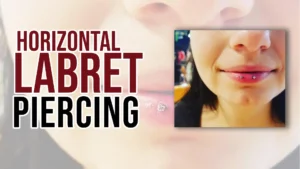Facial piercings used as body art are remarkable. If you decide to pursue one, you must also be ready to accept the procedure, which entails developing the courage to get pierced and maintaining discipline during the aftercare. But with so many different facial features, how can you decide which one to enhance? The Medusa piercing is a delicate but fashionable area to wear jewelry. Are you curious if you’re prepared to commit? Don’t worry; we talked to the experts so that you would know what to anticipate.
What is Medusa Piercing?
A medusa piercing lies in the recessed area of your upper lip, directly above the Cupid’s bow. While decorative terms for lip piercings like Monroe, Madonna, Marilyn, and the Medusa piercing sound astounding and catchy, technically and professionally, they are all considered lip piercings. The philtrum, which is named after the anatomical region of the piercing location, is a special case because it has a name for this particular lip piercing. It is also known as philtrum piercing.
Types of Medusa Piercing

The double and the vertical medusa piercings are the other two varieties.
Double Medusa Piercing
In order to accommodate two separate studs, the philtrum is twice perforated, one on top of the other.
Vertical Medusa Piercing
Because the philtrum is perforated vertically, two holes may appear to be one. This makes the vertical variation unique.
The Procedure of Medusa Piercing
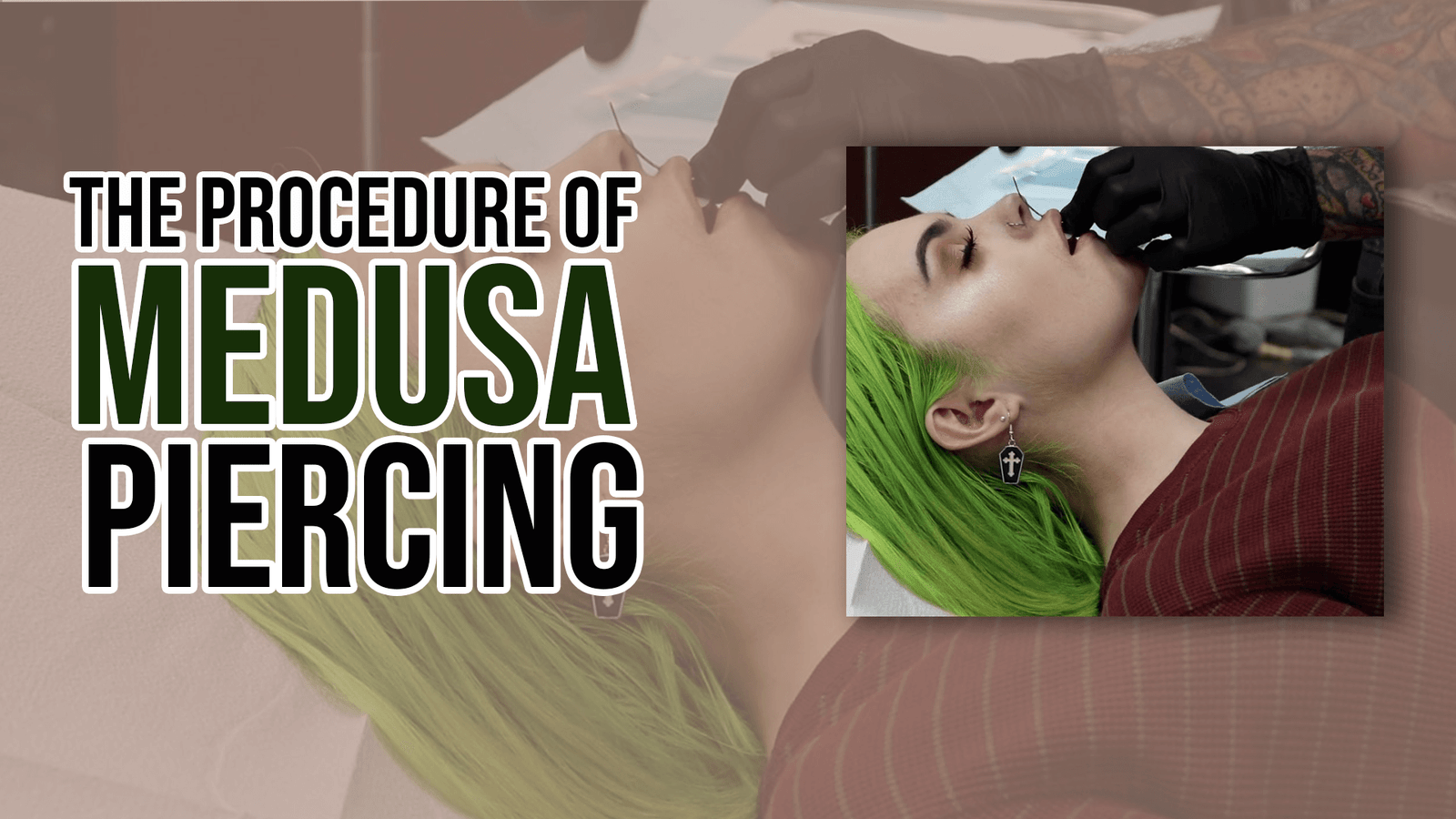
- Before setting up the equipment, they’ll use and your jewelry, the piercing expert should wear gloves.
- Any used instruments should be removed from their sterilized pouches in your presence.
- They will use a medical scrub to clean and disinfect the piercing site, and you will rinse your mouth with an alcohol-free mouthwash.
- They will next assess your anatomy to determine the ideal placement, label it, and check to make sure it’s over or under the gum line, in the center on the outside, and lines up on the inside.
- With forceps clamped, the piercer carefully pulls the tissue away from the remainder of the mouth.
- The next step is to pass a needle through from the outside to the inside. They will remove the forceps and use a guide or taper pin to drive the needle out.
- The piercer will then push the jewelry inside the mouth into the piercing once a pin has been inserted or threaded.
- With the hemostats in hand, they will grasp the post after removing the pin and either screw on end or force it into position.
- They will then apply pressure and saline to stop any bleeding and clean up the area.
- You’ll use an alcohol-free mouthwash once more to rinse.
- Your piercer will go through the aftercare instructions with you before giving you written instructions to take home.
Pain Level of Medusa Piercing
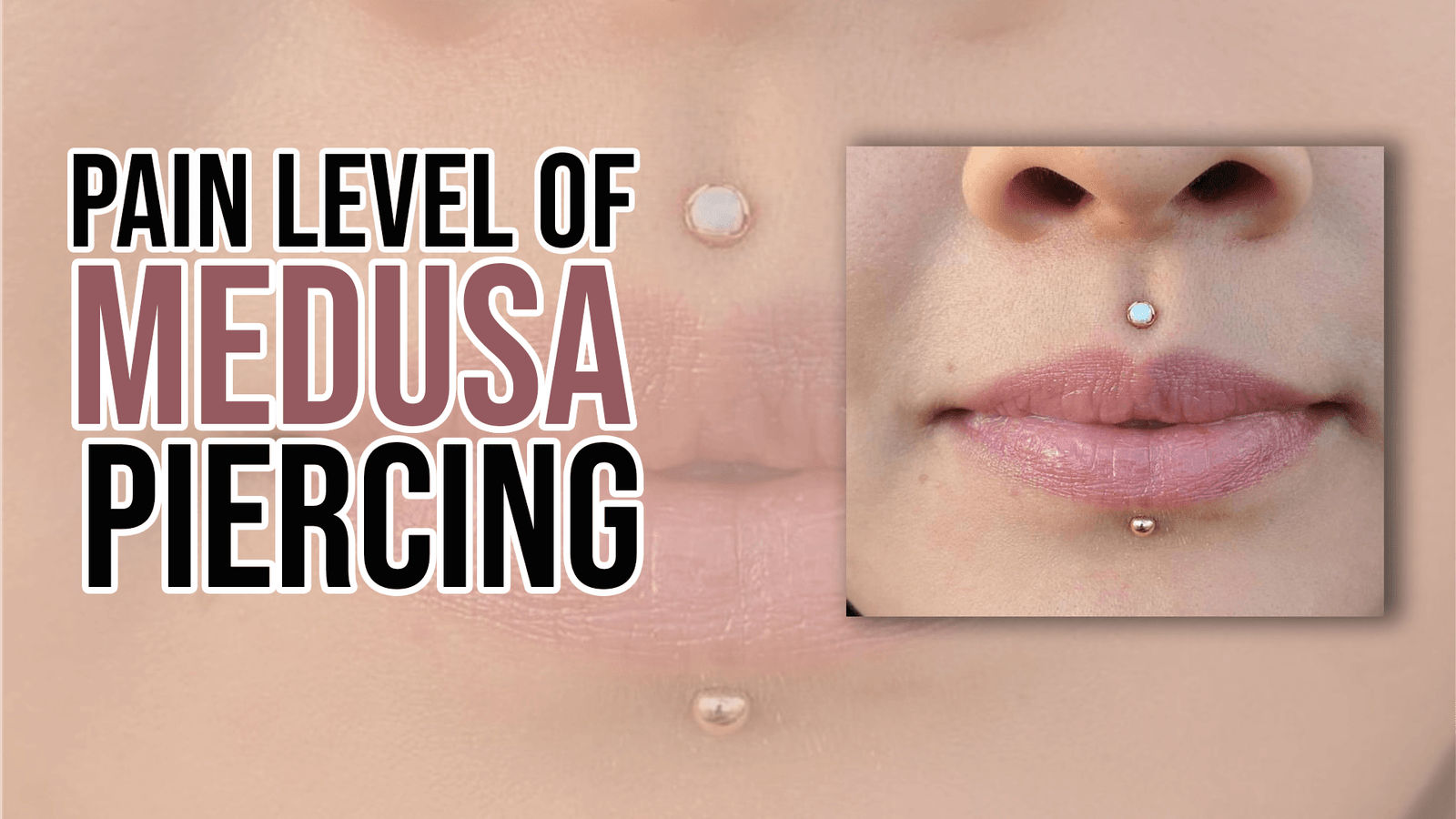
There will be some discomfort during the piercing procedure since the lips and the area around them have more nerve endings than other body parts. The Medusa requires one puncture, which your piercer will accomplish in a single fluid motion, so the pinch will only last briefly before beginning to throb like any other piercing. It’s normal to expect swelling near the Medusa piercing. This is normal for all lip piercings, so don’t be afraid.
Pay attention to the jewelry if your Medusa piercing expands. You’ll need to ask your piercer to change the jewelry for a larger size if it starts to press on the skin. After a few days, after the swelling has subsided, you can change your jewelry size.
Healing Time of Medusa Piercing
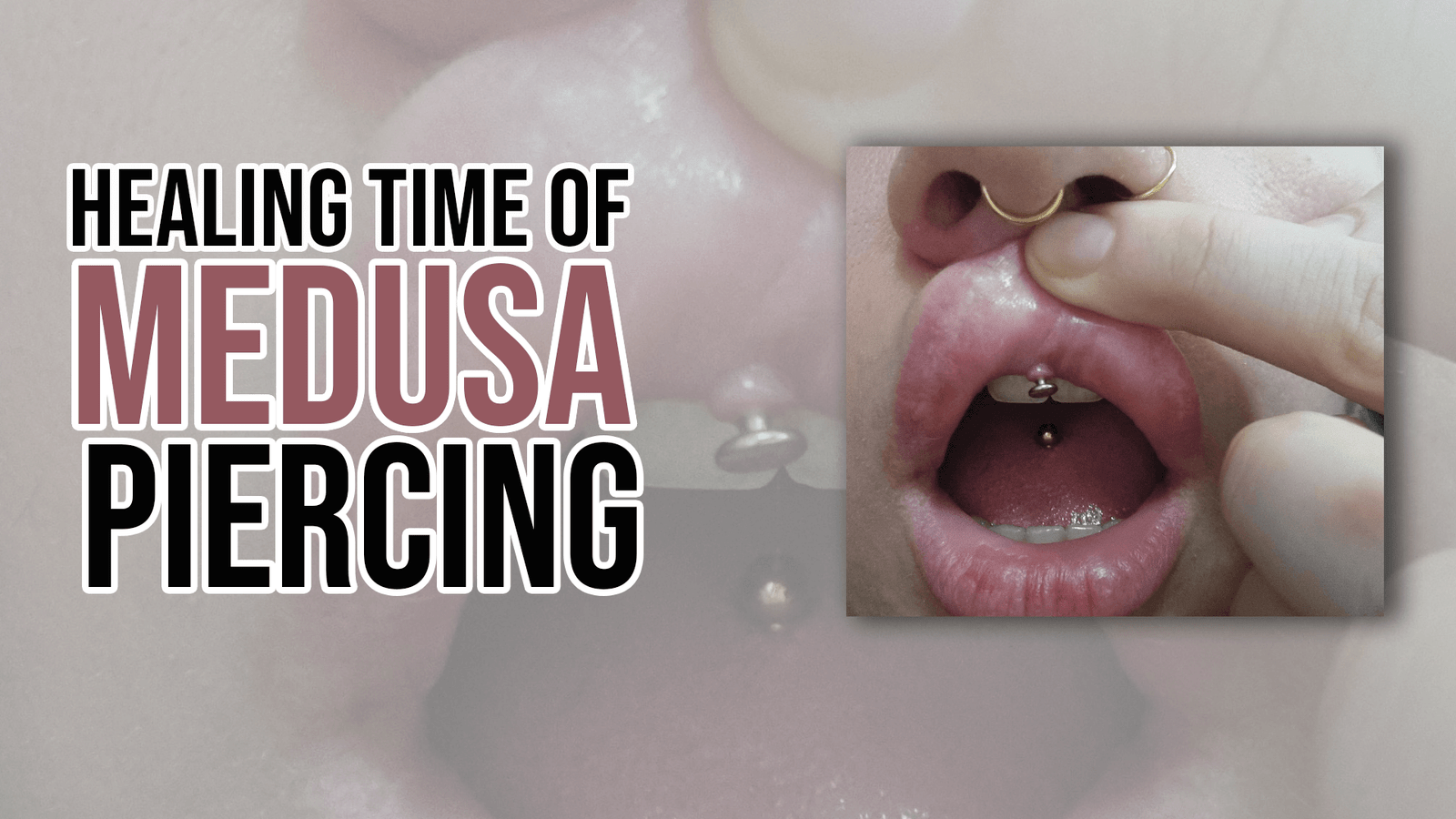
Healing time for a Medusa piercing ranges from 8 to 12 weeks. How well and quickly you heal can be influenced by how well you care for yourself and your piercing. Oral piercings heal rather rapidly, but the interior of the wound might take longer to recover fully.
Aftercare for Medusa Piercing

It would be best to take extra precautions to keep your Medusa piercing safe until it completely heals.
Cleaning
It is necessary to clean your healing Medusa piercing with a piercing aftercare saline solution two to three times each day, as instructed by your piercer. Make sure to select an aftercare solution that is made up solely of salt and water. Some post-piercing care products include ingredients like tea tree oil that are supposed to speed healing but slow it down.
Watch out for your Swelling
The Medusa piercing is prone to swelling in the initial few days following piercing. You need to keep an eye on your jewelry as it swells. Too-small jewelry might press on the piercing and traumatize the piercing site. After a few days, when the swelling has subsided, you can (and ought to) transition to a smaller jewelry item.
Avoid Touching Your Jewelry
To remove crusties, rather than picking at them or twisting the jewelry to get rid of them, gently wipe the area with a fresh paper towel soaked in saline solution. Take care to only move the piercing jewelry once it is clean.
Keep it Dry
Avoid taking baths; when you shower, try to keep the piercing as dry as possible. Use a paper towel to gently dab the piercing dry, or use your hair dryer’s cool setting to let it air dry.
Avoid Make-up and Beauty Products
Makeup will likely enter a healed piercing and cause discomfort, bumps, and infections. Keep all cosmetics and other facial items away from the piercing site while it heals.
Oral Hygiene
Oral hygiene is crucial when mending any lip piercing, but it also necessitates specific attention. Consider brushing your teeth after each meal, but take great care around piercings to avoid yanking out the jewelry. It would be best not to use alcohol-containing mouthwash since it will aggravate your piercing. Instead, swish some salty water around.
Avoid Acidic and Spicy Foods
In addition to being unpleasant to eat, acidic and spicy foods may inflame the piercing and result in piercing bumps. Choose soft foods that don’t require chewing for the first few days after obtaining the Medusa piercing while you adjust to the new jewelry.
Risk Factors of Medusa Piercing
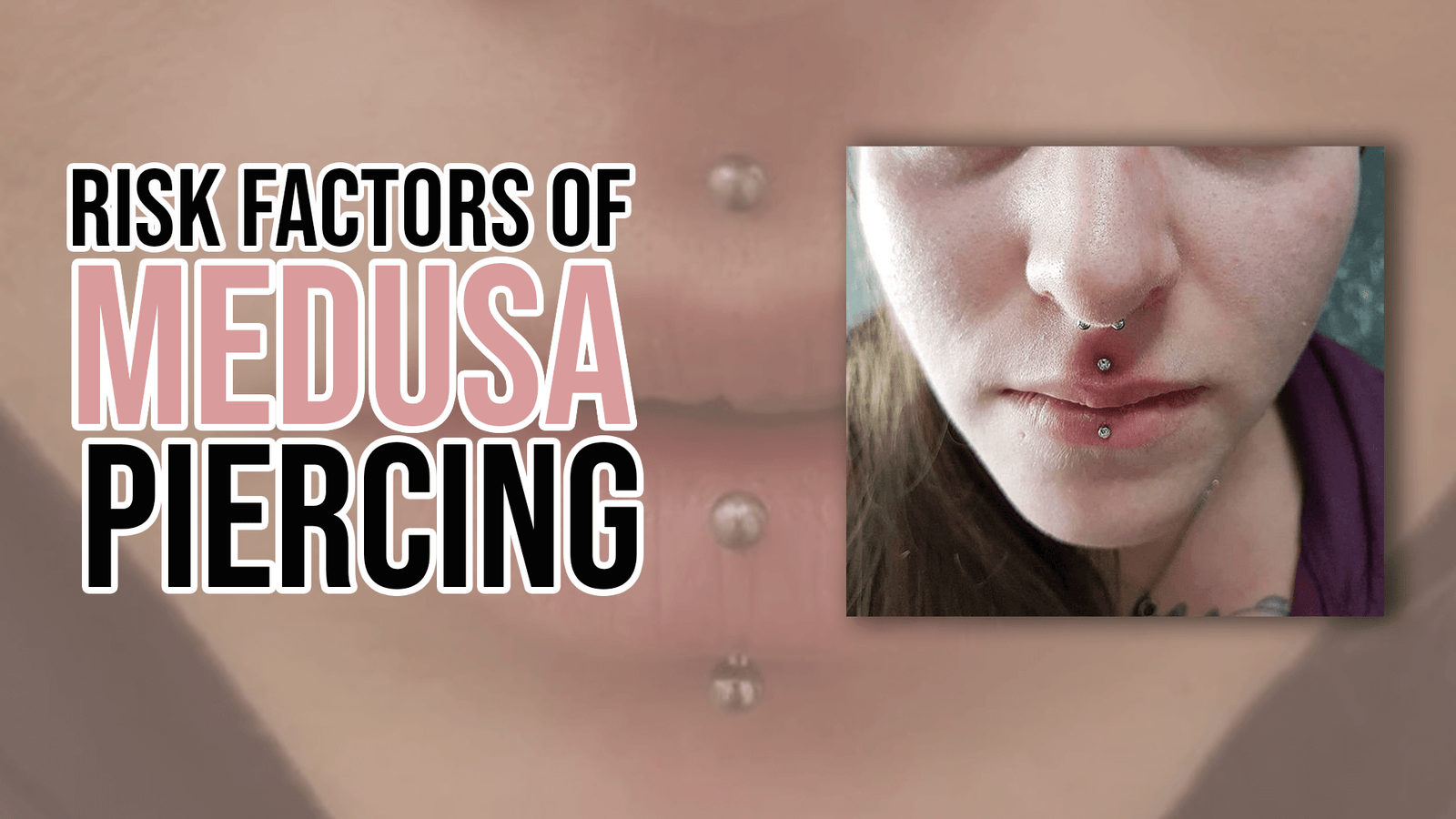
There is a chance of negative consequences, just like with every piercing. You can avoid the majority of these side effects with sufficient care. However, hiccups can occur, and a side effect may manifest occasionally, even when everything has been done correctly.
Piercing Rejection
When your body decides that the jewelry shouldn’t be there, it is said to have rejected the piercing. It usually occurs due to faulty jewelry installation, inappropriate jewelry materials, or injury to the piercing site, although occasionally, it merely happens by accident. If you observe any signs of piercing rejection, such as the piercing hole enlarging, the skin around the piercing turning red and flaky, or the jewelry moving noticeably, speak to your piercer. To prevent any scarring or other marks, you must move quickly.
Piercing Bumps
One of the most frequent Medusa piercing side effects is piercing bumps, which usually develop due to inflammation. Anything other than piercing aftercare saline solution, such as cosmetics, face wash, tea tree oil, or other products, should be kept away from the piercing to prevent piercing bumps. Avoid touching or picking at the piercing; try not to snag it. Don’t panic if a piercing bump develops; they typically go gone on their own. Ask your piercer to examine it so you may talk about your treatment options.
Infection
Infections from medusa piercings are a potential adverse effect, but they are less frequent than you might imagine. You are extremely unlikely to acquire a piercing infection if you have been daily cleansing your piercing.
Swelling
You may notice some swelling but it should decrease in a few days. Philtrum piercings frequently experience some localized edema. With the proper aftercare, it ought to go away on its own.
Crusting
Philtrum piercings frequently produce drainage throughout the healing process. It’s common for this to cause the crust to form around the puncture. Avoid picking at it or removing anything by force. Instead, you can use a sterile saline spray to let the debris fall off naturally.
Gum and Teeth Damage
An often-ignored adverse effect of poorly done mouth piercings is tooth and gum damage. If a Philtrum piercing is performed improperly, the jewelry will probably produce mouth trauma and, over time, may cause irreparable harm. What is good news? “A skilled piercer’s proper and strategic placement should help minimize any possible adverse effects linked to oral piercings.” The negative? “Gums and teeth are not regenerative. Thus harm that has been done can rarely be reversed and not readily, painlessly, or economically.
Medusa Piercing Jewelry
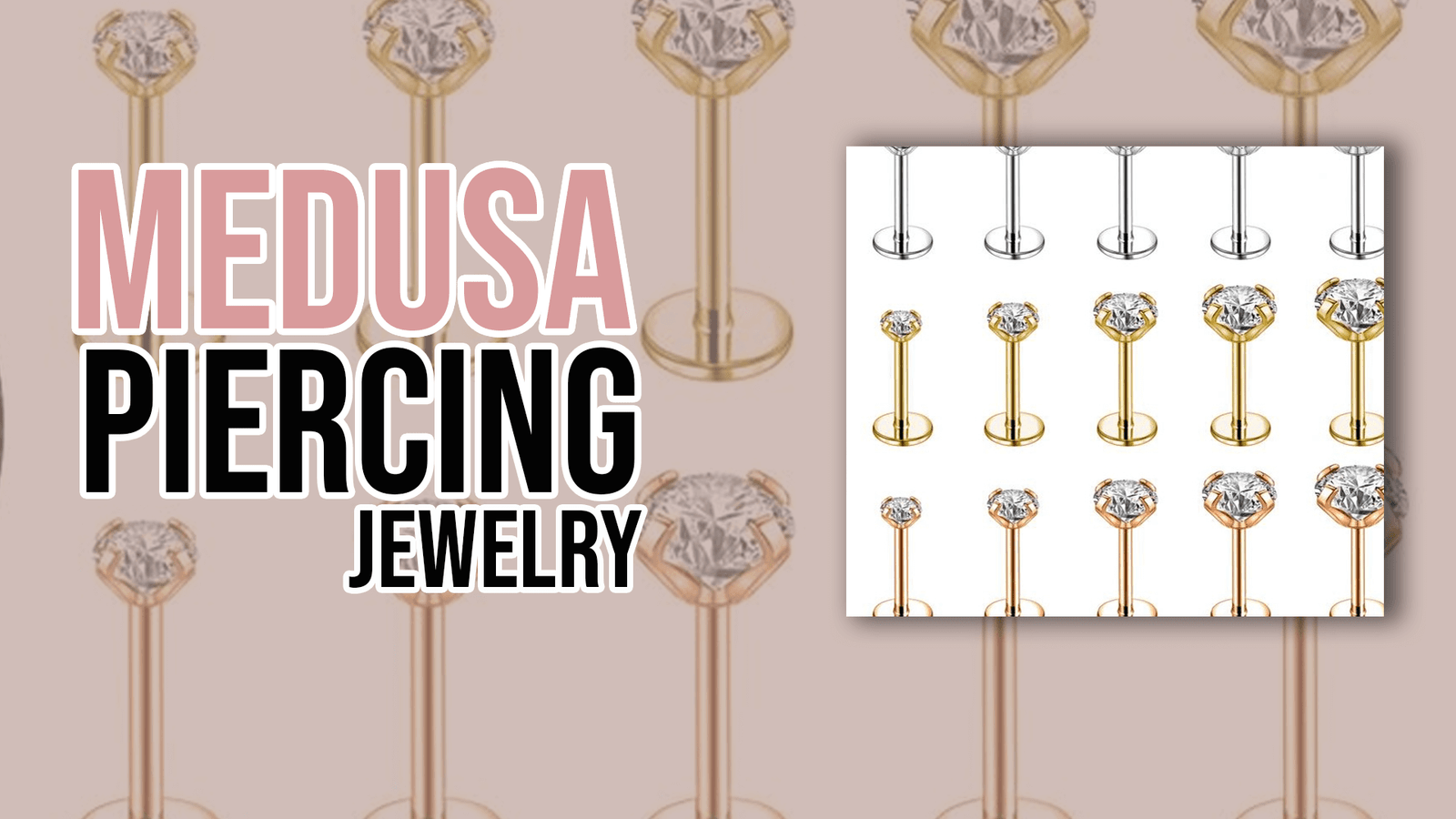
Now that we’ve addressed the problematic aspects, it’s time to move on to the fun part of this lovely piercing—the jewelry.
Material for Jewelry
There are only a few viable body jewelry materials available, despite the abundance of options for body jewelry materials. Titanium is a good choice for entry-level jewelry. It won’t bother your skin because titanium is cheap and doesn’t have many alloys. However, because it will take a little bit to account for swelling, starting jewelry should only be worn for the first week or so. Once the swelling has subsided, you can upgrade to a stunning 14k gold or platinum item. These two materials make beautiful jewelry strong enough to endure a lifetime.
Type of Jewelry for Medusa Piercing
Lip piercing studs are the most common piece of jewelry a Medusa wears. A barbell, a flat disc back, and a bead or charm fastened to the front make up a lip stud. To prevent snags or tears, you should choose internally threaded jewelry.
The most common lip stud sizes for Medusa piercings are 14G or 16 G. Make sure the lip stud doesn’t stretch too far or pinch too firmly while selecting the barbell’s length. Too-small jewelry can become embedded in the skin, while larger jewelry may scrape against your gums and cause your gum line to recede.
Cost of Medusa Piercing
When selecting a piercing studio, the cost can directly reflect the level of jewelry quality and technical skill your body will be exposed to. The jewelry you choose will always influence the ultimate price at any studio. Typically, it falls between $40 and $100.
We are considered a quality jewelry gallery since we mostly employ solid gold and naturally mined diamonds. The least expensive item starts at around $150 but could easily reach four figures or more, depending on your jewelry preferences.
Final Thoughts
In conclusion, the Medusa piercing has revolutionized the realm of body alteration. It is an alluring and audacious form of self-expression. Its seductive placement on the upper lip, evoking the fascinating gaze of the fabled Medusa, attracts interest and piques curiosity. The Medusa piercing has evolved into a sign of self-assurance and individuality due to its capacity to accentuate facial characteristics and encourage people to embrace their distinctive style. This piercing enables you to make a strong statement and embrace your inner rebel, whether you wear a simple stud or dabble with intricate jewelry. So, if you’re prepared to up your piercing game, let the Medusa piercing serve as your guide on a quest for self-awareness and creative expression. Bring out your inner Medusa, and let your piercings symbolize your daring and robust nature.





